Baltimore, Maryland, Hgh State Clinic, Hgh Injections, Hrt Doctors
Baltimore, Maryland Blood Testing Facilities
 Represents a LabCorp blood testing facility
Represents a LabCorp blood testing facility Represents a Quest Diagnostics blood testing facility
Represents a Quest Diagnostics blood testing facility

Nearby Labcorp Blood Testing facilities:
- Labcorp Center Distance: 2 m, 3700 Fleet St Ste 101, Baltimore, Other, MD, 21224
- Labcorp Center Distance: 3 m, 3449 Wilkens Ave Ste 207, Baltimore, Other, MD, 21229
- Labcorp Center Distance: 5 m, 1576 Merritt Blvd Ste 3, Dundalk, Baltimore County, MD, 21222
- Labcorp Center Distance: 6 m, 7801 York Rd Ste 360, Towson, Baltimore County, MD, 21204
- Labcorp Center Distance: 7 m, 4 W Rolling Crossroads 15, Catonsville, Baltimore County, MD, 21228
- Labcorp Center Distance: 8 m, 6820 Hospital Dr Ste 301, Baltimore, Baltimore County, MD, 21237
- Labcorp Center Distance: 9 m, 1838 Greene Tree Rd Ste 115, Pikesville, Baltimore County, MD, 21208
- Labcorp Center Distance: 10 m, 25 Crossroads Dr Ste 40, Owings Mills, Baltimore County, MD, 21117
- Labcorp Center Distance: 11 m, 8028 Ritchie Hwy Ste 112, Pasadena, Anne Arundel County, MD, 21122
- Labcorp Center Distance: 12 m, 9501 Old Annapolis Rd Ste 100, Ellicott City, Howard County, MD, 21042
- Labcorp Center Distance: 13 m, 5450 Knoll North Dr Ste 150, Columbia, Howard County, MD, 21045
- Labcorp Center Distance: 15 m, 11055 Little Patuxent Pkwy 210, Columbia, Howard County, MD, 21044
- Labcorp Center Distance: 18 m, 2401 Brandermill Blvd Ste 210, Gambrills, Anne Arundel County, MD, 21054
- Labcorp Center Distance: 19 m, 13944 Baltimore Ave Unit 1, Laurel, Prince George's County, MD, 20707
- Labcorp Center Distance: 20 m, 7350 Van Dusen Rd Ste B, Laurel, Prince George's County, MD, 20707
- Labcorp Center Distance: 21 m, 602 S Atwood Rd 204, Bel Air, Harford County, MD, 21014
- Labcorp Center Distance: 24 m, 12200 Annapolis Rd Suite 120, Glenn Dale, Prince George's County, MD, 20769
- Labcorp Center Distance: 25 m, 7525 Greenway Center Dr Ste 104, Greenbelt, Prince George's County, MD, 20770
- Labcorp Center Distance: 26 m, 11120 New Hampshire Ave Ste 306, Silver Spring, Montgomery County, MD, 20904
- Labcorp Center Distance: 27 m, 6510 Kenilworth Ave. Ste 1500, Riverdale, Prince George's County, MD, 20737
- Labcorp Center Distance: 28 m, 2112 Didonato Dr Ste F, Chester, Queen Anne's County, MD, 21619
- Labcorp Center Distance: 29 m, 3311 Toledo Terrace Ste B101, Hyattsville, Prince George's County, MD, 20782
- Labcorp Center Distance: 31 m, 11119 Rockville Pike Ste G101, Rockville, Montgomery County, MD, 20852
- Labcorp Center Distance: 32 m, 106 Irving Street Nw Ste 1506, Washington, Other, DC, 20010
- Labcorp Center Distance: 33 m, 9711 Medical Center Dr Ste 222, Rockville, Montgomery County, MD, 20850
- Labcorp Center Distance: 34 m, 9560 Pennsylvania Ave. Ste 203, Upper Marlboro, Prince George's County, MD, 20772
- Labcorp Center Distance: 35 m, 1133 21St St Nw Bldg 2, Washington, Other, DC, 20036
- Labcorp Center Distance: 37 m, 1328 Southern Ave Se Ste 207, Washington, Other, DC, 20032
- Labcorp Center Distance: 38 m, 1005 N Glebe Rd Ste 140, Arlington, Arlington County, VA, 22201
- Labcorp Center Distance: 39 m, 6188 Oxon Hill Rd Ste 104, Oxon Hill, Prince George's County, MD, 20745
- Labcorp Center Distance: 42 m, 5130 Duke St Ste 10, Alexandria, Other, VA, 22304
- Labcorp Center Distance: 43 m, 141 Thomas Johnson Dr Ste 100, Frederick, Frederick County, MD, 21702
- Labcorp Center Distance: 44 m, 239 Pauline Dr (S York Plaza), York, York County, PA, 17402
- Labcorp Center Distance: 45 m, 8101 Hinson Farm Rd Ste 314, Alexandria, Fairfax County, VA, 22306
- Labcorp Center Distance: 46 m, 401 Purdy St Ste 202, Easton, Talbot County, MD, 21601
- Labcorp Center Distance: 47 m, 300 E Pulaski Hwy Ste 111, Elkton, Cecil County, MD, 21921
- Labcorp Center Distance: 48 m, 120 Sandhill Dr Suite 1, Middletown, New Castle County, DE, 19709
- Labcorp Center Distance: 49 m, 366 East Main Street, Middletown, New Castle County, DE, 19709
- Labcorp Center Distance: 50 m, 2600 Glasgow Ave Ste 214, Newark, New Castle County, DE, 19702
- Labcorp Center Distance: 52 m, 222 Catoctin Cir Se Ste 100, Leesburg, Loudoun County, VA, 20175
- Labcorp Center Distance: 53 m, 314 E Main St Ste 105, Newark, New Castle County, DE, 19711
- Labcorp Center Distance: 54 m, 330 North Arch St Unit 1, Lancaster, Lancaster County, PA, 17603
- Labcorp Center Distance: 55 m, 15 Shining Willow Way, La Plata, Charles County, MD, 20646
- Labcorp Center Distance: 56 m, 4623 Ogletown Stanton Rd 100, Newark, New Castle County, DE, 19713
- Labcorp Center Distance: 57 m, 503 Byrn St 2Nd Fl, Cambridge, Dorchester County, MD, 21613
- Labcorp Center Distance: 58 m, 14010 Smoketown Road Ste 101, Woodbridge, Prince William County, VA, 22192
- Labcorp Center Distance: 59 m, 8609 Sudley Rd Ste 104, Manassas, Other, VA, 20110
- Labcorp Center Distance: 60 m, Stone Mill Plz 722 Yorklyn Rd, Hockessin, New Castle County, DE, 19707
- Labcorp Center Distance: 61 m, 2701 Kirkwood Hwy, Wilmington, New Castle County, DE, 19805
- Labcorp Center Distance: 63 m, 338 Mill St, Hagerstown, Washington County, MD, 21740
- Labcorp Center Distance: 64 m, 1010 N Bancroft Pkwy Ste L2, Wilmington, New Castle County, DE, 19805
Nearby Quest Blood Testing facilities:
- Quest Center Distance: 3 m, 2300 Garrison Blvd, Baltimore, Other, MD, 21216-2309
- Quest Center Distance: 7 m, 2 East Rolling Crossroads, Catonsville, Baltimore County, MD, 21228-6212
- Quest Center Distance: 8 m, 1205 York Road, Lutherville, Baltimore County, MD, 21093-6211
- Quest Center Distance: 10 m, 23 Crossroads Dr, Owings Mills, Baltimore County, MD, 21117-5420
- Quest Center Distance: 11 m, 9055 Chevrolet Drive, Ellicott City, Howard County, MD, 21043-4091
- Quest Center Distance: 15 m, 11055 Little Patuxent Pkwy, Columbia, Howard County, MD, 21044-2897
- Quest Center Distance: 19 m, 1532 Liberty Road, Eldersburg, Carroll County, MD, 21784-6460
- Quest Center Distance: 20 m, 820 Bestgate Rd, Annapolis, Anne Arundel County, MD, 21401-3404
- Quest Center Distance: 21 m, 620 W Macphail Road, Bel Air, Harford County, MD, 21014-4474
- Quest Center Distance: 24 m, 4000 Mitchellville Road, Bowie, Prince George's County, MD, 20716-3124
- Quest Center Distance: 25 m, 6201 Greenbelt Rd, College Park, Other, MD, 20740-2358
- Quest Center Distance: 27 m, 10801 Lockwood Drive, Silver Spring, Montgomery County, MD, 20901-1563
- Quest Center Distance: 33 m, 9707 Medical Center Drive, Rockville, Montgomery County, MD, 20850-6335
- Quest Center Distance: 34 m, 20528 Boland Farm Road, Germantown, Montgomery County, MD, 20876-4038
- Quest Center Distance: 35 m, 1145 19Th St, Nw, Washington, US, DC, 20036-3713
- Quest Center Distance: 40 m, 611 S Carlin Springs Road, Arlington, Arlington County, VA, 22204-1061
- Quest Center Distance: 43 m, 165 Thomas Johnson Dr, Frederick, Frederick County, MD, 21702-4314
- Quest Center Distance: 44 m, 8501 Arlington Blvd, Fairfax, Fairfax County, VA, 22031-4632
- Quest Center Distance: 45 m, 6162 Fuller Ct, Alexandria, Fairfax County, VA, 22310-2540
- Quest Center Distance: 46 m, 1748 6Th Ave, York, York County, PA, 17403-2643
- Quest Center Distance: 47 m, 304 North St, Elkton, Cecil County, MD, 21921-5570
- Quest Center Distance: 48 m, 10721 Main Street, Fairfax, Other, VA, 22030-6912
- Quest Center Distance: 49 m, 21785 Filigree Court, Ashburn, Loudoun County, VA, 20147-6214
- Quest Center Distance: 50 m, 300 Biddle Ave, Newark, New Castle County, DE, 19702-3972
- Quest Center Distance: 51 m, 521 E. Market St., Leesburg, Loudoun County, VA, 20176-4170
- Quest Center Distance: 53 m, 1011 Baltimore Pike,, West Grove, US, PA, 19390-9402
- Quest Center Distance: 56 m, 215 Granite Run Dr, Lancaster, Lancaster County, PA, 17601-6805
- Quest Center Distance: 57 m, 2080 Daniel Stuart Square, Woodbridge, Prince William County, VA, 22191-3315
- Quest Center Distance: 58 m, 12731 Marblestone Dr, Woodbridge, Prince William County, VA, 22192-8307
- Quest Center Distance: 59 m, 8685 Sudley Rd, Manassas, Other, VA, 20110-4588
- Quest Center Distance: 60 m, 525 E Basin Rd, New Castle, New Castle County, DE, 19720-4230
- Quest Center Distance: 62 m, 402 Mcfarlan Rd, Kennett Square, Chester County, PA, 19348-2453
- Quest Center Distance: 63 m, 956 Justison St, Wilmington, New Castle County, DE, 19801-5149
- Quest Center Distance: 64 m, 181 N Broadway, Pennsville, Salem County, NJ, 08070-1550
- Quest Center Distance: 66 m, 112 N Reading Rd, Ephrata, Lancaster County, PA, 17522-1646
- Quest Center Distance: 67 m, 975 N Dupont Hwy, Milford, Kent County, DE, 19963-1072
- Quest Center Distance: 68 m, 2700 Silverside Rd, Wilmington, New Castle County, DE, 19810-3724
- Quest Center Distance: 69 m, 4824 Londonderry Rd, Harrisburg, Dauphin County, PA, 17109-5245
- Quest Center Distance: 70 m, 808 Middleford Rd, Seaford, Sussex County, DE, 19973-3650
- Quest Center Distance: 71 m, 608 Garrisonville Rd, Stafford, Stafford County, VA, 22554-3706
- Quest Center Distance: 72 m, Rt 422 West, Lebanon, Lebanon County, PA, 17042-2568
- Quest Center Distance: 73 m, 80 W Welsh Pool Rd, Exton, Chester County, PA, 19341-1233
- Quest Center Distance: 74 m, 216 Laurel Heights Dr, Bridgeton, Cumberland County, NJ, 08302-3634
- Quest Center Distance: 75 m, 1167A W Baltimore Pike, Media, Delaware County, PA, 19063-5121
- Quest Center Distance: 77 m, 725 E Lincoln Ave, Myerstown, Lebanon County, PA, 17067-2260
- Quest Center Distance: 78 m, 520 E Lancaster Ave, Shillington, Berks County, PA, 19607-1365
- Quest Center Distance: 79 m, 501 W Macdade Boulevard, Folsom, Delaware County, PA, 19033-3203
- Quest Center Distance: 80 m, 1001 Baltimore Pike, Springfield, Delaware County, PA, 19064-2852
- Quest Center Distance: 81 m, Phoenixville Plaza, Phoenixville, Chester County, PA, 19460-3344
- Quest Center Distance: 82 m, 1011 Care Way, Fredericksburg, Other, VA, 22401-4454
- Quest Center Distance: 83 m, 223 Shoemaker Rd, Pottstown, Montgomery County, PA, 19464-6433
Baltimore Hormone Replacement Therapy Services
How much do you know about your body? Do you know how important your Hormones are with regard to maintaining your health and wellness? How do you know if you have Hormone Imbalance, and what treatment options are available for you as a patient? The Conscious Evolution Institute can answer these questions and more, and they can provide you with quality Hormone Therapy Treatments designed to encourage hormone balance and help you reach a state of better health. We have the tools and knowledge at our disposal to help you improve your quality of life for years to come!
Our clinic has affiliates located all throughout the Baltimore area, as well as the entire state of Maryland. With the help of these local physicians, we can establish your Hormone Balance and help you decide if HRT Therapy is right for you. With just a single appointment and blood test, our Hormone Specialists have all of the health data necessary to paint a clear and vivid picture of your Hormone State and recommend ways to optimize and revitalize your life.
Baltimore HGH Injections for Growth Hormone Deficiency
One of the premier health services that we provide at the Conscious Evolution Institute is Human Growth Hormone Replacement Therapy. HGH is, out of all of the hormones produced by the body, the most important for preserving health and wellness with age. Human Growth Hormone controls cell metabolism, and, therefore, plays a role in optimizing the function of practically every physiological system of the body. Unfortunately, HGH Production starts to fall around age 30, and this impacts the body's ability to meet its needs, leading to a variety of symptoms that leave people in a constant state of decline.
HGH Deficiency can be diagnosed by testing a patients' IGF-1 Levels, which directly correlate to average Human Growth Hormone Production over time. Symptoms of Human Growth Hormone Deficiency include weight gain, loss of muscle mass, trouble healing, loss of strength, issues sleeping, lack of energy, reduced exercise capacity, and declining libido. Let us evaluate your HGH Levels and provide you with Human Growth Hormone Injection Therapy!
Baltimore Sermorelin Acetate HGH Replacement
Along with HGH Injection Therapy, the Conscious Evolution Institute also offers Sermorelin Acetate Injection Therapy, which is also capable of alleviating the effects of Age-Associated HGH Decline. Sermorelin is the functional analog of a Hormone known as GH-RH, which is released by the brain to stimulate Growth Hormone production by the pituitary.
Many medical and healthcare professionals feel that Sermorelin is the better choice for many patients, as compared to Human Growth Hormone, because Sermorelin stimulates the brain to produce its own, natural Growth Hormone. The brain still has the ability to regulate HGH Production, so it doesn't lead to overdose. Sermorelin is also popular because it is quite a bit cheaper than Bio-Identical Growth Hormone, while also available for off-label prescription, a benefit not available to Bio-Identical HGH.
Baltimore Testosterone Replacement for Low-T
Testosterone is the number-one most important Androgen Hormone for men, and it does more than just encourage male development, it also preserves male health. Testosterone is a potent metabolic hormone which also facilitates sex drive and sexual function. Testosterone helps men stay thinner and stronger, and it also helps ward against anxiety and depression. Men with healthy Testosterone Levels are less likely to suffer from conditions ranging from hypertension and atherosclerosis to diabetes and osteoporosis. Testosterone Deficiency can be effectively treated through the use of Testosterone Replacement Therapy, and there are many forms of treatment, which provide patients with many potential avenues to improve their health, including Testosterone Gels, Testosterone Injections, and Testosterone Skin Patches.
Baltimore HCG Weight Loss Injections
The HCG Diet is another of the many great Hormone Treatments that our Health and Hormone Clinic provides. HCG is short for Human Chorionic Gonadotropin, and researchers and healthcare professionals have discovered that HCG encourages weight loss when combined with a low calorie diet. With HCG Injections, patients have experienced dramatic weight loss to the tune of thirty pounds in thirty days. This may sound difficult, but HCG makes it easier, silencing the hunger and cravings usually associated with such diets, while also stimulating the body to burn body fat while protecting muscle mass. If you have tried other diets without finding the diet right for you, consider HCG Injection Therapy.
Baltimore, Maryland Information
Baltimore is a major port city that is located along the Chesapeake Bay. The Baltimore economy largely revolves around its various ports, and Baltimore is actually the second most productive port city on the mid-American coast of the Atlantic Ocean. Baltimore goes by a number of nicknames, including Ravenstown, the City of Firsts, The Land of Pleasant Living, and Charm City.
For most of Baltimore's history, the city was an incredibly important location for American manufacturing and production. As times have changed and manufacturing jobs have left the city, Baltimore now revolves around services. Major employers in Baltimore include Royal Farms, T. Rowe Price, McCormick & Company, Legg Mason, and Under Armour. Baltimore is a city with an immense amount of history, and this history drives tourists to visit the city. Things to do in Baltimore include the Hippodrome Theater, the Baltimore Symphony Orchestra, and Fort Mchenry. Many people come to Baltimore to see the amazing historical sea vessels that are on display in the port. The USS Torsk and the USS Constellation are both available for tours.
Baltimore is one of America's original big sports towns, and has a notable presence on the landscape of American professional athletics. Baltimore is the home of the Baltimore Orioles and the Baltimore Ravens, both of which have a strong history of athletic excellence. Perhaps the most well-known event that is held in Baltimore is the Preakness Stakes, which is one of the three races every year which comprise the illusive Triple Crown. Public higher education in Baltimore includes the University of Baltimore, Morgan State University and Coppin State University. Private universities in Baltimore include St. Mary's, Loyola University Marymount, and Johns Hopkins University.
All About Baltimore, Maryland Geographic Area
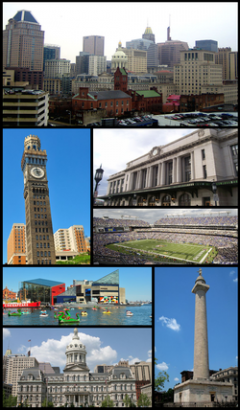
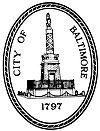
"Get in on it." "The city that reads."
Baltimore ( /ËnbÉaltɨmÉer/, colloquially /ËnbÉel.mÉer/) is the largest city in the U.S. state of Maryland and the 24th largest city in the country. It is located in the central area of the state along the tidal portion of the Patapsco River, an arm of the Chesapeake Bay. The independent city is often referred to as Baltimore City to distinguish it from surrounding Baltimore County. Founded in 1729, Baltimore is the largest seaport in the Mid-Atlantic United States and is situated closer to Midwestern markets than any other major seaport on the East Coast. Baltimore's Inner Harbor was once the second leading port of entry for immigrants to the United States and a major manufacturing center. After a decline in manufacturing, Baltimore shifted to a service-oriented economy.
/ËnbÉaltɨmÉer/, colloquially /ËnbÉel.mÉer/) is the largest city in the U.S. state of Maryland and the 24th largest city in the country. It is located in the central area of the state along the tidal portion of the Patapsco River, an arm of the Chesapeake Bay. The independent city is often referred to as Baltimore City to distinguish it from surrounding Baltimore County. Founded in 1729, Baltimore is the largest seaport in the Mid-Atlantic United States and is situated closer to Midwestern markets than any other major seaport on the East Coast. Baltimore's Inner Harbor was once the second leading port of entry for immigrants to the United States and a major manufacturing center. After a decline in manufacturing, Baltimore shifted to a service-oriented economy.
At 620,961 residents in 2010, Baltimore's population has decreased by one-third since its peak in 1950. The Baltimore Metropolitan Area has grown steadily to approximately 2.7 million residents in 2010; the 20th largest in the country. Baltimore is also a principal city in the larger Baltimore aeWashington combined statistical area of approximately 8.4 million residents. The city is named after Cecilius Calvert, Lord Baltimore, a member of the Irish House of Lords and the founding proprietor of the Maryland Colony. Baltimore is an anglicization of the Irish Gaelic name Baile an TR MhR³ir, meaning "town of the big house", from which Baltimore, County Cork derives its name.
The Maryland colonial General Assembly created the Port of Baltimore at Locust Point in 1706 for the tobacco trade. The Town of Baltimore was founded on July 30, 1729, and is named after Lord Baltimore (Cecilius Calvert), who was the first Proprietary Governor of the Province of Maryland. Cecilius Calvert was a son of George Calvert, who became the First Lord Baltimore of County Cork, Ireland in 1625. Baltimore grew swiftly in the 18th century as a granary for sugar-producing colonies in the Caribbean. The profit from sugar encouraged the cultivation of cane and the importation of food.
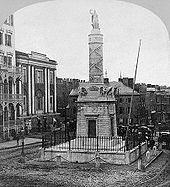
Baltimore played a key part in events leading to and including the American Revolution. City leaders such as Jonathan Plowman Jr. moved the city to join the resistance to British taxes and merchants signed agreements to not trade with Britain. The Second Continental Congress met in the Henry Fite House from December 1776 to February 1777, effectively making the city the capital of the United States during this period. After the war, the Town of Baltimore, nearby Jonestown, and an area known as Fells Point were incorporated as the City of Baltimore in 1796. The city remained a part of Baltimore County until 1851 when it was made an independent city.
The city was the site of the Battle of Baltimore during the War of 1812. After burning Washington, D.C., the British attacked Baltimore on the night of September 13, 1814. United States forces from Fort McHenry successfully defended the city's harbor from the British. Francis Scott Key, a Maryland lawyer, was aboard a British ship where he had been negotiating for the release of an American prisoner, Dr. William Beanes. Key witnessed the bombardment from this ship and after seeing the huge American flag on the morning of September 14, 1814, he wrote "The Star-Spangled Banner", a poem recounting the attack. Key's poem was set to a 1780 tune by British composer John Stafford Smith, and the Star-Spangled Banner became the official National Anthem of the United States in 1931.
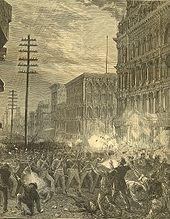
Following the Battle of Baltimore, the city's population grew rapidly. The construction of the Federally funded National Road (which later became part of U.S. Route 40) and the private Baltimore and Ohio Railroad (B&O) made Baltimore a major shipping and manufacturing center by linking the city with major markets in the Midwest. A distinctive local culture started to take shape, and a unique skyline peppered with churches and monuments developed. Baltimore acquired its moniker, "The Monumental City" after an 1827 visit to Baltimore by President John Quincy Adams. At an evening function Adams gave the following toast: "Baltimore: the Monumental City- May the days of her safety be as prosperous and happy, as the days of her dangers have been trying and triumphant." Baltimore suffered one of the worst riots of the antebellum south in 1835, when bad investments led to the Baltimore bank riot.
Maryland, a slave state, did not secede from the Union during the American Civil War; however, when Union soldiers marched through the city at the start of the war, Confederate sympathizers attacked the troops, which led to the Baltimore riot of 1861. Four soldiers and 12 civilians were killed during the riot, which caused Union troops to occupy Baltimore. Maryland came under direct federal administration aein part, to prevent the state from seceding aeuntil the end of the war in April 1865.
Following an economic depression known as the Panic of 1873, the Baltimore & Ohio Railroad company attempted to lower its workers' wages, leading to the Great Railroad Strike of 1877. On July 20, 1877, Maryland Governor John Lee Carroll called up the 5th and 6th Regiments of the National Guard to end the strikes, which had disrupted train service at Cumberland in western Maryland. Citizens sympathetic to the railroad workers attacked the national guard troops as they marched from their armories in Baltimore to Camden Station. Soldiers from the 6th Regiment fired on the crowd, killing 10 and wounding 25. Rioters then damaged B&O trains and burned portions of the rail station. Order was restored in the city on July 21 ae22 when federal troops arrived to protect railroad property and end the strike.
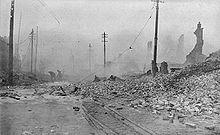
On February 7, 1904, the Great Baltimore Fire destroyed over 1,500 buildings in 30 hours, leaving more than 70 blocks of the downtown area burned to the ground. Damages were estimated at $150 million aein 1904 dollars. As the city rebuilt during the next two years, lessons learned from the fire led to improvements in firefighting equipment standards.
The city grew in area by annexing new suburbs from the surrounding counties, the last being in 1918, when the city acquired portions of Baltimore County and Anne Arundel County. A state constitutional amendment approved in 1948, required a special vote of the citizens in any proposed annexation area, effectively preventing any future expansion of the city's boundaries.
The relative size of the city's black population grew from 23.8% in 1950 to 46.4% in 1970. The Baltimore riot of 1968 occurred following the assassination of Martin Luther King, Jr. in Memphis, Tennessee on April 4, 1968. Coinciding with riots in other cities, public order was not restored until April 12, 1968. The Baltimore riot cost the city of Baltimore an estimated $10 million (US$ 67 million in 2012). A total of 11,000 Maryland National Guard and federal troops were ordered into the city. Lasting effects of the riot can be seen on the streets of North Avenue, Howard Street, Gay Street, and Pennsylvania Avenue where long stretches of the streets remain barren. The city experienced tumult again in 1974 when teachers, municipal workers, and police officers all conducted strikes.
During the 1970s, Baltimore's downtown area known as the Inner Harbor, had been neglected and was only occupied by a collection of abandoned warehouses. Efforts to redevelop the downtown area started with the construction of the Baltimore Convention Center, which opened 1979. Harborplace, an urban retail and restaurant complex opened on the waterfront in 1980, followed by the National Aquarium in Baltimore, Maryland's largest tourist destination, and the Baltimore Museum of Industry in 1981. In 1992, the Baltimore Orioles baseball team moved from Memorial Stadium to Oriole Park at Camden Yards, located downtown near the harbor. Six years later the Baltimore Ravens football team moved into M&T Bank Stadium next to Camden Yards.
The city has 280 properties identified as historical in the National Register of Historic Places.
The historical records of the government of Baltimore City are located at the Baltimore City Archives.
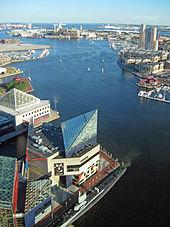
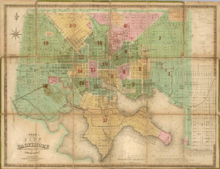
Baltimore is in north-central Maryland on the Patapsco River close to where it empties into the Chesapeake Bay. The city is also located on the fall line between the Piedmont Plateau and the Atlantic Coastal Plain, which divides Baltimore into "lower city" and "upper city". The city's elevation ranges from sea level at the harbor to 480 feet (150 m) in the northwest corner near Pimlico.
According to the 2010 Census, the city has a total area of 92.052 square miles (238.41 km2), of which 80.944 sq mi (209.64 km2) is land and 11.108 sq mi (28.77 km2) is water. The total area is 12.07 percent water.
Under the Koppen classification, Baltimore lies within the humid subtropical climate zone (Cfa), and has four distinct seasons. Spring and autumn are warm, with spring being the wettest season in terms of the number of precipitation days. Winters are cool with occasional snowfall: January has a daily average of 36.8 °F (2.7 °C), and the average seasonal snowfall is 20.2 inches (51 cm), though temperatures reach 50 °F (10 °C) rather often and can occasionally drop below 20 °F ( na7 °C). Freezing rain and sleet occurs a few times each winter in the area, as warm air overrides cold air at the low-mid levels of the atmosphere. When the wind blows from the east, the cold air gets dammed against the mountains to the west and the result is freezing rain or sleet. Summers are hot and humid with a daily average in July of 81.7 °F (27.6 °C), and the combination of heat and humidity leads to rather frequent thunderstorms.
Due to an urban heat island effect in the city proper and a moderating effect of the Chesapeake Bay, the outlying and inland parts of the Baltimore metro area are usually cooler than the city proper and the coastal towns. Thus, in the northern and western suburbs, winter snowfall is more significant, and some areas average more than 30 inches (76 cm) of snow per year.
Extreme temperatures range from na7 °F ( na22 °C) in February 1934 up to 107 °F (42 °C) in July 1936. On average, 100 °F (37.8 °C)+ temperatures occur on 1.1 days annually, 90 °F (32.2 °C)+ in excess of 31 days, and there are 12 days where the high fails to breach the freezing mark. The average date of first frost in Baltimore is October 29, and the average last frost is April 11, allowing a growing season of 200 days. Baltimore lies within USDA plant hardiness zones 7 and 8.


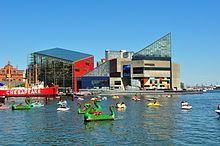
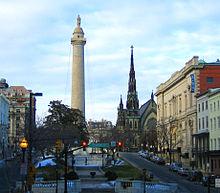
Baltimore exhibits examples from each period of architecture over more than two centuries, and work from many famous architects such as Benjamin Latrobe, George A. Frederick, John Russell Pope, Mies Van Der Rohe and I. M. Pei.
The city has architecturally important buildings in a variety of styles. The Baltimore Basilica (1806 ae1821) is a neoclassical design by Benjamin Latrobe, and also the oldest Catholic Cathedral in the United States. In 1813 Robert Cary Long, Sr. built for Rembrandt Peale the first substantial structure in the United States designed expressly as a museum. Restored, it is now the Municipal Museum of Baltimore, or popularly the auPeale Museum au. The McKim Free School was founded and endowed by John McKim, although the building was erected by his son Isaac in 1822 after a design by William Howard and William Small. It reflects the popular interest in Greece when the nation was securing its independence, as well as a scholarly interest in recently published drawings of Athenian antiquities.
The Phoenix Shot Tower (1828), at 234.25 feet (71.40 m) tall, was the tallest building in the United States until the time of the Civil war. It was constructed without the use of exterior scaffolding. The Sun Iron Building designed by R.C. Hatfield in 1851, was city aos first iron-front building and it was a model for a whole generation of downtown buildings. Brown Memorial Presbyterian Church, built in 1870 in memory of financier George Brown, has stained glass windows by Louis Comfort Tiffany and has been called "one of the most significant buildings in this city, a treasure of art and architecture" by Baltimore Magazine. The 1845 Greek Revival style Lloyd Street Synagogue is one of the oldest synagogues in the United States. The Johns Hopkins Hospital, designed by Lt. Col. John S. Billings in 1876 was a considerable achievement for its day in functional arrangement and fireproofing.
I.M.Pei's World Trade Center (1977) is the tallest equilateral pentagonal building in the world at 405 feet (123 m) tall.
The Inner Harbor East area has seen the addition of two new towers which have completed construction: a 24-floor tower that is the new world headquarters of Legg Mason, and a 21-floor Four Seasons Hotel complex.
The streets of Baltimore are organized in a grid pattern, lined with tens of thousands of brick and formstone faced rowhouses. In The Baltimore Rowhouse, Mary Ellen Hayward and Charles Belfoure considered the rowhouse as the architectural form defining Baltimore as "perhaps no other American city." In the mid 1790s, developers began building entire neighborhoods of the British-style rowhouses, which became the dominant house type of the city early in the 19th century.
Formstone facings, now a common feature on Baltimore rowhouses, were an addition patented in 1937 by Albert Knight. John Waters characterized formstone as "the polyester of brick" in his 30 minute documentary film, Little Castles: A Formstone Phenomenon.
Oriole Park at Camden Yards is considered by many to be the most beautiful baseball park in Major League Baseball, and has inspired many other cities to build their own versions of this retro style ballpark. Camden Yards along with the National Aquarium have helped revive the Inner Harbor from what once was an industrial district full of dilapidated warehouses, into a bustling commercial district full of bars, restaurants and retail establishments.
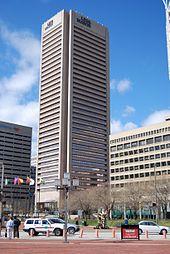
Baltimore is divided officially into nine geographical regions: Northern, Northwestern, Northeastern, Western, Central, Eastern, Southern, Southwestern, and Southeastern, with each patrolled by a respective Baltimore Police Department district. However, it is common for locals to divide the city simply by East or West Baltimore, using Charles Street as a dividing line, and/or into North and South using Baltimore Street as a dividing line.
The Central district includes Downtown Baltimore, the city's main commercial area. Home to Harborplace, The Camden Yards Sports Complex (Oriole Park at Camden Yards and M&T Bank Stadium), the Convention Center, and the National Aquarium in Baltimore, the area also includes many nightclubs, bars and restaurants, shopping centers and various other attractions. Many of Baltimore's key businesses, such as Legg Mason and Constellation Energy are based here. In addition, the University of Maryland, Baltimore campus is housed in this area, with the long-associated University of Maryland Medical System adjacent to the school. The downtown core has mainly served as a commercial district with limited residential opportunities. However, since 2002 the downtown population has doubled to 12,000 residents. The Central district stretches north of the downtown core up to the edge of Druid Hill Park. This northern portion of Central, between downtown and the park, is home to many of the city's cultural opportunities. Maryland Institute College of Art, the Peabody Institute of music, the Lyric Opera House, The Walters Art Museum, The Joseph Meyerhoff Symphony Hall, as well as several galleries are located in this region.
Crime in the Inner Harbor and Mount Vernon neighborhoods of the Central district became of greater concern in 2009, as an increasing number of random assaults on tourists were reported.
The Northern District lies directly north of the Central district and is bounded on the east by The Alameda and on the west by Pimlico Road. Loyola University Maryland, The Johns Hopkins University and College of Notre Dame of Maryland are located in this district as well as the affluent residential neighborhood of Roland Park, the first planned suburban community in America.
The Southern District, a mixed industrial and residential area, consists of the area of the city below the Inner Harbor, east of the B&O railroad tracks. It is a mixed socio-economic region consisting of working class, culturally and ethnically diverse neighborhoods such as Locust Point; the historic Federal Hill area, home to many working professionals, pubs and restaurants; and low-income residential areas such as Cherry Hill. The Port of Baltimore operates two terminals in this district and the old Domino Sugar plant is located here. Westport is another lower-income neighborhood that has been approved for tremendous waterfront development in the years to come. (See Westport Waterfront)
East Baltimore consists of the Northeastern, Eastern, and Southeastern districts.
The Northeastern district is primarily a residential neighborhood, home to Morgan State University, bounded by the city line on its northern and eastern boundaries, Sinclair Lane, Erdman Avenue, and Pulaski Highway on its southern boundaries and The Alameda on its western boundaries. It has undergone demographic shifts over many years and has become predominantly African American.
The Eastern district is the heart of what is considered East Baltimore and is home to Johns Hopkins Hospital and Johns Hopkins University School of Medicine. Located below Erdman Avenue and Sinclair Lane, above Orleans Street, it is an almost exclusively African American area, made up of low-income residential neighborhoods. Entire blocks of abandoned buildings and its chronic problem with drug trafficking made this area a frequent on-site film location for The Wire, a television drama produced from 2002 to 2008.
The Southeastern district, located below Orleans Street, bordering the Inner Harbor on its western boundary, the city line on its eastern boundaries and the Baltimore harbor on its southern boundaries, is a mixed industrial and residential area. The demography of individual neighborhoods varies widely, from predominantly black O'Donnell Heights, where 66 percent of the population was measured below the poverty line in 2000, to predominantly white Fells Point, with less than 17 percent below the poverty line. Yet, even these two neighborhoods have a significant mix of other races and cultures, a common characteristic of Southeastern neighborhoods.
West Baltimore consists of the Northwestern, Western, and Southwestern districts.
The Northwestern district, bounded by the county line on its northern and western boundaries, Gwynns Falls Parkway on the south and Pimlico Road on the East, is home to Pimlico Race Course, Sinai Hospital. Its neighborhoods are mostly residential. Formerly the center of Baltimore's Jewish community, the district's Park Heights neighborhood, has undergone white flight since the 1960s, becoming an almost exclusively black.
Northern Parkway divides the Northwestern district into two distinctly different demographic areas. Neighborhoods to the north of the parkway, such as Mount Washington and Cheswolde are predominantly white, with low-density suburban housing. South of the parkway, the neighborhoods are mostly black. Some of the neighborhoods south of the parkway also have suburban housing, but several are high density urban communities, with greater percentage of residents reported below the poverty level in the 2000 census.
The Western district, located west of downtown, is the heart of West Baltimore, bounded by Gwynns Falls Parkway, Fremont Avenue, and Baltimore Street. Coppin State University, Mondawmin Mall, and Edmondson Village, located in this district, have been historic cultural and economic centers of the city's African American community. Once home to many middle to upper class African Americans, over the years the more affluent residents have migrated to other sections of the city or beyond the city line into Baltimore County and Howard County.
Income levels below the poverty line were reported by the 2000 census for more than 45 percent of residents in some of the district's neighborhoods, which are almost exclusively black. Like East Baltimore, the area's crime problems have provided subject material for television series, such as The Wire.
Local organizations, such as the Sandtown Habitat for Humanity and the Upton Planning Committee, have been steadily transforming formerly blighted areas of the Western district into clean, safe and well-kept communities.
The Southwestern district is bounded by Baltimore County to the west, Baltimore Street to the north, and the downtown area to the east. St. Agnes Hospital is located in this district, amid a mix of industrial parks and residential areas. Economic and demographic characteristics of Southwestern district vary greatly. Almost exclusively black, the Uplands neighborhood, near the Central district, had 39.9 percent of its residents measured below the poverty line by the 2000 census. Predominantly white Violetville, at the city's southwest edge, had only 6.4 percent of its residents reported below the poverty line.

Belair-Edison

Homeland

Woodberry

Stonewood

Charles Village

Carrollton Ridge

Station North

Fells Point

Roland Park
The City of Baltimore is bordered by the following communities, all unincorporated census-designated places.
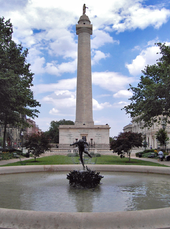
Historically a working-class port town, Baltimore has sometimes been dubbed a "city of neighborhoods," with 72 designated historic districts traditionally occupied by distinct ethnic groups. Most notable today are three downtown areas along the port: the Inner Harbor, frequented by tourists due to its hotels, shops, and museums; Fells Point, once a favorite entertainment spot for sailors but now refurbished and gentrified (and featured in the movie Sleepless in Seattle); and Little Italy, located between the other two, where Baltimore's Italian-American community is based ae and where former U.S. House Speaker Nancy Pelosi grew up. Further inland, Mt. Vernon is the traditional center of cultural and artistic life of the city; it is home to a distinctive Washington Monument, set atop a hill in a 19th century urban square, that predates the more well-known monument in Washington, D.C. by several decades.
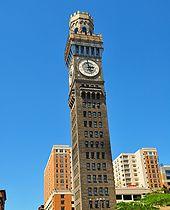
Each year the Artscape takes place in the city in the Bolton Hill neighborhood, due to its proximity to Maryland Institute College of Art. Artscape styles itself as the 'largest free arts festival in America'. Each May, the Maryland Film Festival takes place in Baltimore, using all 5 screens of the historic Charles Theatre as its anchor venue.
The nickname "Charm City" comes from a 1975 meeting of advertisers seeking to improve the city's reputation.
One thing visitors quickly notice is that some locals refer to their city as "Balamer," dropping the "t". The traditional local white accent, peculiar to some working-class areas of the city, has long been noted and celebrated as "Baltimorese" or "Bawlmorese." Baltimoreans are also often asked to pronounce words like "to" and "do" as it's said they pronounce it "tew" and "dew". As a member of the Mid-Atlantic English dialect group, Baltimore's dialect shares many characteristics with Philadelphia's, such as the addition of an "eh" sound before a long "o". Its influence distinguishes Baltimore, especially with words containing "oi" flattened into an "aw" sound. Baltimore is also known for its use of Hun or Hon.
Baltimore native John Waters parodies the city and its dialect extensively in his films. Most of them are filmed and/or set in Baltimore, including the 1972 cult classic Pink Flamingos, as well as Hairspray and its Broadway musical remake.
The Baltimore Symphony Orchestra is an internationally renowned orchestra, founded in 1916 as a publicly funded municipal organization. The current Music Director is Marin Alsop, a protege of Leonard Bernstein. Center Stage is the premier theater company in the city and a regionally well-respected group. The Baltimore Opera was an important regional opera company, though it filed for bankruptcy in 2008 and is not currently performing. The Baltimore Consort has been a leading early music ensemble for over twenty-five years. The France-Merrick Performing Arts Center, home of the restored Thomas W. Lamb-designed Hippodrome Theatre, has afforded Baltimore the opportunity to become a major regional player in the area of touring Broadway and other performing arts presentations.
Baltimore also boasts a wide array of professional (non-touring) and community theater groups. Aside from Center Stage, resident troupes in the city include Everyman Theatre, Single Carrot Theatre, and Baltimore Theatre Festival. Community theaters in the city include Fells Point Community Theatre and the Arena Players Inc., which is the nation's oldest continuously operating African American community theater. In 2009, the Baltimore Rock Opera Society, an all-volunteer theatrical company, launched its first production.
Baltimore is home to the Pride of Baltimore Chorus, a 3-time International silver medalist women's chorus, affiliated with Sweet Adelines International.
Baltimore is where the non-profit chamber music organization Vivre Musicale calls home. VM won a 2011 ae2012 CMA/ASCAP award for Adventurous Programming.
The city is also home to the Baltimore School for the Arts, a public high school in the Mount Vernon neighborhood of Baltimore. The institution is nationally recognized for its success in preparation for students entering music (vocal/instrumental), theatre (acting/theater production), dance, or visual arts.
Once a predominantly industrial town, with an economic base focused on steel processing, shipping, auto manufacturing, and transportation, the city experienced deindustrialization which cost residents tens of thousands of low-skill, high-wage jobs. The city now relies on a a low-wage service economy, which accounts for 90% of jobs in the city. Baltimore's unemployment rate in July 2012 was 11%, and the 2012 closure of a major steel plant at Sparrows Point is expected to have a further impact on employment and the local economy. One quarter of Baltimore residents (and 37% of Baltimore children) live in poverty.[100]
The city is home to the Johns Hopkins Hospital. Other large companies in Baltimore include Under Armour,[101] Cordish Company,[102] and Royal Farms.[103] A sugar refinery owned by American Sugar Refining is one of Baltimore's cultural icons.
At the 2010 Census, there were 620,961 people residing in Baltimore, a decrease of 4.6% since 2000. According to the 2010 Census, 63.7% of the population was Black, 29.6% White, 0.4% American Indian and Alaska Native, 2.3% Asian, 0.2% from some other race (non-Hispanic) and 2.1% of two or more races. 4.2% of Baltimore's population was of Hispanic, Latino, or Spanish origin (they may be of any race). Non-Hispanic Whites were 28% of the population in 2010,[104] compared to 80.6% in 1940.[105] After New York City, Baltimore was the second city in the United States to reach a population of 100,000.[106][107] In the 1830, 1840, and 1850 US censuses, Baltimore was the second-largest city in population,[107][108] surpassed by Philadelphia in 1860.[109] It was among the top 10 cities in population in the United States in every census up to the 1980 census,[110] and after World War II had a population of nearly a million.
Although Baltimore's population has continued to decline since 1950, the number of families living downtown has increased significantly over the past 10 years, according to Downtown Partnership of Baltimore, Inc. Downtown Baltimore aos core area experienced a population increase of 130% since 2000. The area in a one-mile radius of downtown between Pratt and Light Streets grew 13.6% during that time as well. New construction and the conversion of obsolete commercial buildings into residences has been a primary factor for growth in the central city. The average household income in downtown increased 39.7% to $64,128 from $45,895.[111] Despite the increase in the number of families, Baltimore's downtown still lost about 10,000 total residents since the 2000 Census, a decline of about 6%.[112]
According to the U.S. Census Bureau, Baltimore's population lived in a total of 294,579 housing units in 2009. Age ranges were 22.4% under 18 years old, 11.8% at age 65 or older, and 65.8% from 18 to 64 years old. Baltimore's population was 53.4% female.[113] The median age is 35 years old.
A statistical abstract prepared by the U.S. Census Bureau estimated the median income for a household in the city during 2008 at $30,078, and the median income for a family at $48,216. The same abstract also listed a per capita income of $22,885 for the city in 2008, with 15.4% of families and 19.3% of the population below the poverty line.[114]
Despite the housing collapse, and along with the national trends, Baltimore residents still face slowly increasing rent (up 3% in the summer of 2010).[115]
The homeless population in Baltimore is steadily increasing; it exceeded 4000 people in 2011. The increase in the number of young homeless people was particularly severe.[116]
In 2003, the FBI identified irregularities in the number of rapes reported, which was confirmed by then-Mayor Martin O'Malley. The number of homicides in 2005 appeared to exhibit discrepancies as well.[117] Former police commissioner Kevin P. Clark stated upon interview that the administration suppressed corrections to its crime reports;[118] however, many of the charges made by the police commissioner now appear to have been politically motivated.[119] The veracity of crime statistics reported by the Baltimore Police Department once again came under scrutiny in 2006, this time from Maryland legislators.[120]
Baltimore reported 223 homicides in 2010. This has been part of a general trend in all violent crimes for the city, which have declined from 21,799 in 1993 to 9,316 in 2010. Even with stark population decline taken into account aeBaltimore went from 732,968 residents in 1993 to just 620,961 in 2010 aethe drop in violent crime was significant, falling from 3.0 incidents per 100 residents to 1.6 incidents per 100 residents.[121] Baltimore's level of violent crime is still much higher than the national average, however. In 2009, a total of 1,318,398 violent crimes were reported nationwide across the United States, equivalent to a rate of just 0.4 incidents per 100 people.[122]
In 2011, Baltimore police reported 196 homicides, the lowest number of slayings in the city since a count of 197 homicides in 1978 and far lower than the peak homicide count of 353 slayings in 1993. The drop is significant, but the homicide rate is nevertheless in the same range the city saw in the mid 1980s, when the city had another 130,000 residents. City leaders credit a sustained focus on repeat violent offenders and increased community engagement for the continued drop, reflecting a nationwide decline in crime.[123]
Baltimore is an independent city, and not part of any county. For most governmental purposes under Maryland law, Baltimore City is treated as a county-level entity. The United States Census Bureau uses counties as the basic unit for presentation of statistical information in the United States, and treats Baltimore as a county equivalent for those purposes.
Baltimore has been a Democratic stronghold for over 150 years, with Democrats dominating every level of government.[124] The city hosted the first six Democratic National Conventions, from 1832 through 1852, and hosted the DNC again in 1860, 1872, and 1912.[125][126]
Sheila Dixon became the first female mayor of Baltimore on January 17, 2007. As the former City Council President, she assumed the office of Mayor when former Mayor Martin O'Malley took office as Governor of Maryland.[127] On November 6, 2007, Dixon won the Baltimore mayoral election.
Mayor Dixon's administration ended less than three years after her election, the result of a criminal investigation that began in 2006 while she was still City Council President. She was convicted on a single misdemeanor charge of embezzlement on December 1, 2009. A month later, Dixon made an Alford plea to a perjury charge and agreed to resign from office.[128][129] Stephanie Rawlings-Blake, who was City Council President at that time, assumed the office of Mayor on February 4, 2010, when Dixon's resignation became effective.[130]
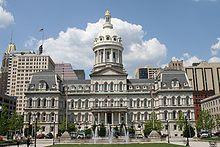
Grassroots pressure for reform, voiced as Question P, restructured the city council in November 2002, against the will of the mayor, the council president, and the majority of the council. A coalition of union and community groups, organized by the Association of Community Organizations for Reform Now (ACORN), backed the effort.[131]
The Baltimore City Council is now made up of 14 single-member districts and one elected at-large council president. Bernard C. "Jack" Young has been the council president since February 2010, when he was unanimously elected by the other council members to replace Stephanie Rawlings-Blake, who had become mayor.[132] Edward Reisinger, the 10th district representative, is the council's current vice president.[133]
Since the legislative redistricting in 2002, Baltimore has had six legislative districts located entirely within its boundaries, giving the city six seats in the 47-member Maryland State Senate and 18 in the 141-member Maryland House of Delegates.[134][135] During the previous 10 year period, Baltimore had four legislative districts within the city limits, but four others overlapped the Baltimore County line.[136] As of January 2011, all of Baltimore's state senators and delegates were Democrats.[134] Approval of the next redistricting plan is expected to become effective in time for Maryland's 2012 Congressional primary election on February 14, 2012. [137]
Three of the state's eight congressional districts include portions of Baltimore: the 2nd, represented by Dutch Ruppersberger; the 3rd, represented by John Sarbanes; and the 7th, represented by Elijah Cummings. All three are Democrats; a Republican has not represented a significant portion of Baltimore in Congress since John Boynton Philip Clayton Hill represented the 3rd District in 1927, and has not represented any of Baltimore since the Eastern Shore-based 1st District lost its share of Baltimore after the 2000 census; it was represented by Republican Wayne Gilchrest at the time.
Both of Maryland's Senators, Ben Cardin and Barbara Mikulski, are from Baltimore, and both represented the 3rd District before being elected to the Senate. Mikulski represented the 3rd from 1977 to 1987, and was succeeded by Cardin, who held the seat until his election and inauguration to the Senate in 2007.[138]
The Postal Service's Baltimore Main Post Office is located at 900 East Fayette Street in the Jonestown area.[139]
The Baltimore City Police Department is the primary law enforcement agency serving the citizens of Baltimore. Campus security for the city's public schools is provided by the Baltimore City Public Schools Police.
The Maryland Transportation Authority Police is the primary law enforcement agency on the Fort McHenry Tunnel Thruway (I-95), the Baltimore Harbor Tunnel Thruway (I-895) and I-395, which are under MdTA jurisdiction and have limited concurrent jurisdiction with the Baltimore Police under a memorandum of understanding.
Law enforcement on the fleet of transit buses and transit rail systems serving Baltimore is the responsibility of the Maryland Transit Administration Police, which is part of the Maryland Transit Administration. The MTA Police also share jurisdiction authority with the Baltimore Police, governed by a memorandum of understanding.[140]
As the enforcement arm of the Baltimore court system, the Baltimore City Sheriff's Office is responsible for the security of city courthouses and property, service of court-ordered writs, protective and peace orders, warrants, tax levies, prisoner transportation and traffic enforcement. Deputy Sheriffs are sworn law enforcement officials, with full arrest authority granted by the constitution of Maryland, the MPCTC and the Sheriff of the City of Baltimore.[141]
The city of Baltimore is protected by the over 1,800 professional firefighters of the Baltimore City Fire Department (BCFD), founded in December 1858. The BCFD operates out of 37 fire stations, located throughout the city.
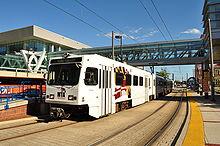
The Interstate Highways serving Baltimore are I-70, I-83 (the Jones Falls Expressway), I-95 (the John F. Kennedy Memorial Highway), I-395, I-695 (the Baltimore Beltway), I-795 (the Northwest Expressway), I-895 (the Harbor Tunnel Thruway), and I-97. Several of the city's Interstate Highways, e.g. I-95, I-83, and I-70 are not directly connected to each other, and in the case of I-70 end at a park and ride lot just inside the city limits, because of freeway revolts in the City of Baltimore. These revolts were led primarily by Barbara Mikulski, now a United States Senator, which resulted in the abandonment of the original plan. U.S. highways and state routes that run to and through downtown Baltimore include US 1, US 40 National Road, and the Baltimore-Washington Parkway. There are two tunnels traversing the Baltimore harbor within the city limits: the four-bore Fort McHenry Tunnel (served by I-95) and the two-bore Harbor Tunnel (served by I-895). The Baltimore Beltway crosses south of Baltimore harbor over the Francis Scott Key Bridge.
Baltimore is a top destination for Amtrak along the Northeast Corridor. Baltimore's Penn Station is one of the busiest in the country. In FY 2008, it ranked 8th in the United States with a total ridership of 1,020,304.[142] Just outside the city, Baltimore/Washington International (BWI) Thurgood Marshall Airport Rail Station is another popular stop. Amtrak's Acela Express, Palmetto, Carolinian, Silver Star, Silver Meteor, Vermonter, Crescent, and Northeast Regional trains are the scheduled passenger train services that stop in the city. Additionally, MARC commuter rail service connects the city's two main intercity rail stations, Camden Station and Penn Station, with Washington, D.C.'s Union Station as well as stops in between.
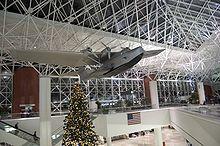
Baltimore is served by Baltimore-Washington International Thurgood Marshall Airport, generally known as "BWI," which lies about 10 miles (16 km) to the south in neighboring Anne Arundel County, and by Martin State Airport, a general aviation facility, to the north in Baltimore County. BWI and Martin State airports are operated by the Maryland Aviation Administration, which is part of the Maryland Department of Transportation.[143] In terms of passenger traffic, BWI is the 24th busiest airport in the United States.[144] Downtown Baltimore is connected to BWI by two major highways (I-95 and the Baltimore-Washington Parkway via Interstate 195), the Baltimore Light Rail, and Amtrak and MARC commuter rail service between Baltimore's Penn Station and BWI Rail Station. Martin State Airport is linked to downtown Baltimore by two major highways, I-95 and U.S. Route 40, and MARC commuter rail service between Baltimore's Penn Station and its nearby Martin State Airport MARC Train stop.
Public transit in Baltimore is provided by the Maryland Transit Administration and Charm City Circulator. The city has a comprehensive bus network, a small light rail network connecting Hunt Valley in the north to BWI airport and Cromwell in the south, and a subway line between Owings Mills and Johns Hopkins Hospital.[145] A proposed rail line, known as the Red Line, which would link the Social Security Administration to Johns Hopkins Bayview and perhaps the Canton and Dundalk communities, is under study as of 2007; a proposal to extend Baltimore's existing subway line to Morgan State University, known as the Green Line, is in the planning stages.[146]
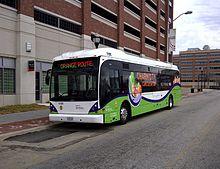
The Charm City Circulator a.k.a. CCC, a shuttle bus service operated by Veolia Transportation for the Baltimore Department of Transportation, began operating in the downtown area in January 2010. Funded partly by a 16 percent increase in the city's parking fees, the circulator provides free bus service seven days a week, picking up passengers every 15 minutes at designated stops during service hours.[147][148]
The CCC's first bus line, the Orange route, travels between Hollins Market and Harbor East. Its Purple route, launched June 7, 2010, operates between Penn Station and Federal Hill. The Green route runs between Johns Hopkins and City Hall.[148][149] The Charm City Circulator operates a fleet of Diesel and Hybrid vehicles built by DesignLine, Orion, and Van Hool.[147]
A 2011 study by Walk Score ranked Baltimore the 14th most walkable of fifty largest U.S. cities.[150]
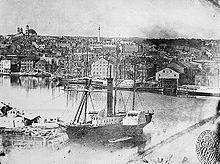
The port was founded in 1706, preceding the founding of Baltimore. The Maryland colonial legislature made the area near Locust Point as the port of entry for the tobacco trade with England. Fells Point, the deepest point in the natural harbor, soon became the colony's main ship building center, later on becoming leader in the construction of clipper ships.[151] After the founding of Baltimore, mills were built behind the wharves. The California Gold Rush led to many orders for fast vessels; many overland pioneers also relied upon canned goods from Baltimore. After the civil war, a coffee ship was designed here for trade with Brazil. At the end of the nineteenth century, European ship lines had terminals for immigrants. The Baltimore and Ohio Railroad made the port a major transshipment point.[152]:17,75
Currently the port has major roll-on roll-off facilities, as well as bulk facilities, especially steel handling.[153] Water taxis also operate in the Inner Harbor. Governor Ehrlich participated in naming the port after Helen Delich Bentley during the 300th anniversary of the port.[154]
In 2007, Duke Realty Corporation began a new development near the Port of Baltimore, named the Chesapeake Commerce Center. This new industrial park is located on the site of a former General Motors plant. The total project comprises 184 acres (0.74 km2) in eastern Baltimore City and the site will yield 2,800,000 square feet (260,000 m2) of warehouse/distribution and office space. Chesapeake Commerce Center has direct access to two major Interstate Highways (I-95 and I-895) and is located adjacent to two of the major Port of Baltimore Terminals. The Port of Baltimore is one of two seaports on the U.S. east coast with a 50-foot (15 m) dredge to accommodate the largest shipping vessels.[155]
Baltimore is the home of numerous places of higher learning, both public and private. Among them are:
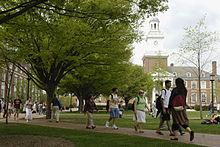
The city's public schools are managed by the Baltimore City Public School System and include schools that have been well-known throughout the area: Carver Vocational-Technical High School, the first African-American vocational high school and center that was established in the state of Maryland; Lake Clifton Eastern High School, which is the largest school campus in Baltimore City of physical size; the historic Frederick Douglass High School, which is the second oldest African-American high school in the United States;[156] Baltimore City College, the third oldest public high school in the country;[157] and Western High School, the oldest public all-girls school in the nation.[158] Baltimore City College (also known as "City") and Baltimore Polytechnic Institute (also known as "Poly") share the nation's second-oldest high school football rivalry.[159]
Baltimore's main newspaper is The Baltimore Sun. It was sold by its Baltimore owners in 1986 to the Times Mirror Company,[160] which was bought by the Tribune Company in 2000.[161] The Baltimore News-American, another long-running paper that competed with the Sun, ceased publication in 1986.[162]
The city is home to the Baltimore Afro-American, an influential African American newspaper founded in 1892.[163][164]
In 2006, The Baltimore Examiner was launched to compete with The Sun. It was part of a national chain that includes The San Francisco Examiner and The Washington Examiner. In contrast to the paid subscription Sun, The Examiner was a free newspaper funded solely by advertisements. Unable to turn a profit and facing a deep recession, The Baltimore Examiner ceased publication on February 15, 2009.
Nielsen ranked Baltimore as the 26th-largest television market for the 2008 ae2009 viewing season and the 27th-largest for 2009 ae2010.[165] Arbitron's Fall 2010 rankings identified Baltimore as the 22nd largest radio market.[166]
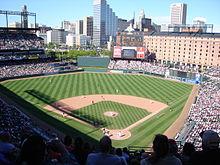
Baltimore has a long and storied baseball history, including the birth of Babe Ruth in 1895. The original 19th century Baltimore Orioles were one of the most successful early franchises, featuring numerous hall of famers during its years from 1882 to 1899. Ruth played for the minor league Baltimore Orioles team, which was active from 1903 to 1914. After playing one season in 1915 as the Richmond Climbers, the team returned the following year to Baltimore, where it played as the Orioles until 1953.[167]
The team currently known as the Baltimore Orioles has represented Major League Baseball locally since 1954 when the St. Louis Browns moved to the city of Baltimore. The Orioles advanced to the World Series in 1966, 1969, 1970, 1971, 1979 and 1983, winning three times (1966, 1970 and 1983), while making the playoffs all but one year (1972) from 1969 through 1974.
In 1995, local player (and later Hall of Famer) Cal Ripken, Jr. broke Lou Gehrig's "unbreakable" streak of 2,130 consecutive games played, for which Ripken was named Sportsman of the Year by Sports Illustrated magazine. Six former Orioles players, including Ripken (2007), and two of the team's managers have been inducted into the Baseball Hall of Fame.
Area fans, such as Wild Bill Hagy, are known for their enthusiasm. Hagy, a cab driver from Dundalk, gained notoriety leading chants from the upper deck of the Memorial Stadium during the 1970s and 1980s.
After moving to Baltimore in 1953, the former Dallas Texans (NFL) played as the Baltimore Colts until 1984. During this period, NFL Hall of Fame quarterback Johnny Unitas set a record of 47 consecutive games with a touchdown pass surpassed only in 2012 by Drew Brees of the New Orleans Saints. The Colts advanced to the NFL Championship twice (1958 & 1959) and Super Bowl twice (1969 & 1971), winning all except Super Bowl III in 1969. The team name previously belonged to an All-America Football Conference which played in Baltimore from 1947 to 1950, then folded after becoming an NFL franchise team in 1950. The team which took the name in 1953 left Baltimore for Indianapolis in 1984, where it became the Indianapolis Colts.
The Baltimore Stallions was an expansion professional football team that joined the Canadian Football League in 1994. It remained in Baltimore for two seasons before relocating to Montreal after the 1995 season to become the Montreal Alouettes. While playing for Baltimore, the team posted the best two season starts of any CFL expansion team ever, advancing to the Grey Cup in both seasons. In its final season in Baltimore, the Stallions became the only U.S. based CFL team to win the Grey Cup, upsetting the heavily favored Calgary Stampeders.
The NFL returned to Baltimore a year after the Stallions left, when the former Cleveland Browns moved to Baltimore to become the Baltimore Ravens in 1996. Since then, the Ravens won a Super Bowl championship in 2000, three AFC North division championships (2003, 2006, and 2011), and appeared in three AFC Championship Games (2000, 2009, and 2011).
Baltimore has two women's American football teams: the Baltimore Burn (founded 2001) and the Baltimore Nighthawks (founded 2007). Both teams play at Art Modell Field.
The Baltimore Mariners, a franchise of the American Indoor Football Association, played at the 1st Mariner Arena from 2008 to 2010. After winning the AIFA championship to cap an undefeated season in 2010, the team folded over charges that owner Dwayne Wells purchased the franchise with embezzled funds.[168]
Baltimore Blast, a franchise of the Major Indoor Soccer League, has been playing at the 1st Mariner Arena since 1992. Originally known as Baltimore Spirit, the team changed its name in 1998. The current name was previously used by another indoor soccer team that played in Baltimore from 1980 to 1992. Since joining the MISL in 2001, the Baltimore Blast have won 5 league championships: 2002, 2003, 2005, 2007 and 2008.
The Baltimore Blues are a semi-professional rugby league football club; they will compete in the USA Rugby League in 2012.[169]
Other professional or semi-professional Baltimore teams include Crystal Palace Baltimore, an outdoor soccer franchise of USL Second Division since 2006; and the Charm City Roller Girls, a member of the Women's Flat Track Derby Association since 2005.
Preakness Stakes, the second jewel in the United States Triple Crown of Thoroughbred Racing, is held every May at Pimlico Race Course in Baltimore.
The Baltimore Grand Prix debuted along the streets of the Inner Harbor section of the city's downtown on September 2 ae4, 2011. The event played host to the American Le Mans Series on Saturday and the IndyCar Series on Sunday. Support races from smaller series were also held, including Indy Lights.
Baltimore has eleven sister cities, as designated by Sister Cities International: [170][171]

Word Count: 8574






